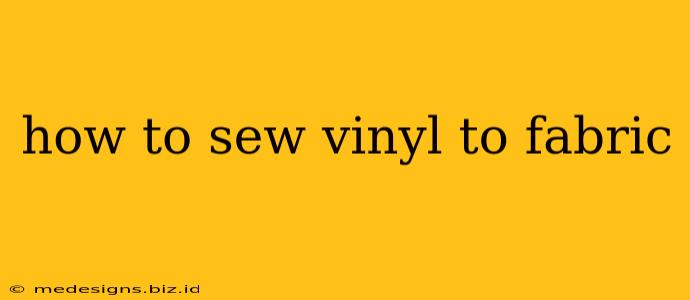Sewing vinyl to fabric might seem daunting, but with the right techniques and tools, it's achievable and surprisingly rewarding. This guide will walk you through the process, ensuring a professional-looking finish for your next project, whether it's a handbag, upholstery, or something completely unique!
Preparing Your Materials: The Foundation for Success
Before you even think about threading your needle, proper preparation is key. This stage will significantly impact the final result and prevent frustrating mishaps.
Choosing the Right Needle and Thread:
- Needle: A microtex needle (size 70/10 or smaller) is your best friend. These needles have a sharp point that easily pierces vinyl without causing skipped stitches or damage. A heavier needle could tear the vinyl, ruining your hard work.
- Thread: Opt for polyester thread. It's strong, durable, and less likely to break compared to other threads. Choose a color that complements your fabric and vinyl. Consider using a specialty thread designed for plastics or synthetics for even more reliable results.
Prepping the Fabric and Vinyl:
- Clean Surfaces: Ensure both your fabric and vinyl are clean and free of dust or debris. Any particles can interfere with the stitching process.
- Stabilize the Vinyl: Vinyl can be slippery and difficult to handle. Using a water-soluble stabilizer on the back of the vinyl before sewing will significantly improve the sewing process and prevent puckering. This is especially crucial for thinner vinyl.
- Consider Interfacing: For added stability, especially with lightweight fabrics, consider using a lightweight fusible interfacing on the fabric side. This helps prevent the fabric from stretching or wrinkling during sewing.
Sewing Techniques: Mastering the Stitch
Now for the exciting part – the actual sewing! Here's how to flawlessly sew vinyl to fabric:
Stitch Selection:
- Short, Straight Stitches: Use a short stitch length (around 1.5-2.0 mm) for a strong, secure seam. This is essential because vinyl doesn't stretch as much as fabric, and shorter stitches prevent tearing.
- Test Your Stitch: Before embarking on your project, always do a test run on a scrap piece of fabric and vinyl to ensure your stitch length, needle, and thread are ideal.
The Sewing Process:
- Pinning (with Caution): Use plenty of pins, but be gentle! Avoid forcing pins through the vinyl, as this can create holes. Use fine pins or clips whenever possible to minimize the risk of puncture marks.
- Slow and Steady: Sew slowly and evenly. Rapid sewing can put extra stress on the needle and thread, increasing the chance of breaks. Take your time and let the machine do the work.
- Avoid Backstitching (If Possible): Backstitching can sometimes damage vinyl. Instead, consider securing your seams by tying a knot at the beginning and end of each seam, or use a slightly longer stitch at the beginning and end.
Troubleshooting and Tips for Success
Sewing vinyl can present unique challenges. Here are some troubleshooting tips:
- Skipped Stitches: Adjust your needle and thread tension. A slightly looser tension on the upper thread might help.
- Puckering: Use a stabilizer or interfacing for extra support. Slow down your stitching speed.
- Tears in Vinyl: Use a sharper needle and be gentler with your pins.
Beyond the Basics: Expanding Your Vinyl Sewing Skills
Once you've mastered the basics, explore more advanced techniques:
- Different Vinyl Types: Experiment with various vinyl weights and textures. Learn how to adapt your techniques based on the vinyl’s characteristics.
- Decorative Stitches: Once comfortable, try using decorative stitches to add a unique touch to your projects.
- Combination Materials: Combine vinyl with other fabrics to create stunning, multi-textured designs.
With practice and patience, sewing vinyl to fabric becomes a manageable and rewarding skill. Don't be discouraged by initial challenges; embrace the learning process, and you'll soon be creating beautiful and durable projects. Remember to always prioritize safety and take your time. Happy sewing!
